How the latest phase of a driverless transport project seeking to scale and expand the deployment of connected and autonomous logistics could future-proof commercial opportunities and drive significant UK growth in the sector. Words by Ursula O’Sullivan-Dale…
The use of automated transport technology is becoming an increasingly high priority for a range of key industries across the UK. Its importance was signalled in February when £81m in combined government and industry funding was made available as part of the Centre for Connected and Autonomous Vehicles Connected and Automated Mobility programme, to help British companies seize early opportunities to develop experimental projects into offerings ready for the market.
When driverless technology is mentioned, people usually think of one thing – self-driving passenger cars. However, the potential number of use cases for driverless transport technology is massive. In one field in particular the use of autonomous driving technology is becoming increasingly prevalent – logistics.
One pioneering example of the wealth of benefits offered by driverless tech in logistics was the 5G CAL (Connected and Autonomous Logistics) project, based in Sunderland, which, between March 2021 and June 2022, saw a consortium of partners convert a 40-tonne diesel truck into an electric vehicle that could, via the 5G network, be both teleoperated and driven autonomously without an onboard safety operator.
Project partners for the first phase of the experiment included the North East Automotive Alliance (NEAA), Sunderland City Council, Newcastle University, Nissan, Vantec, Coventry University, Connected Places Catapult, StreetDrone and Perform Green. Some £2.4m of the overall £4.8m in funding came from the Department for Digital, Culture, Media & Sport.
The chief goal of the proof-of-concept project was to assess how 5G connected and autonomous logistics can drive more efficiency into industrial supply-chain operations. It aimed to do so by automating the delivery of passenger vehicle parts and assemblies along private road infrastructure at carmaker Nissan’s 800-acre Sunderland manufacturing plant.
And last year, StreetDrone’s autonomous and teleoperation technology was built into a Terberg truck and successfully trialled along a predetermined route, with a remote driver taking over teleoperation at certain points of the journey. For the rest of the trial, the truck completed its functions autonomously.
Then, in February, it was announced that the project – renamed V-CAL – would enter a second phase following the awarding of £8m in the recent government-industry funding round. Phase 2 will see the consortium scale the deployment on the initial proof-of-concept into actual operational conditions and also expand into alternative, more complex routes, which aims to build scale, reliability, and consistency of operation. It will run up to four zero-emission autonomous HGVs around the Nissan Sunderland site, on private roads, where the vehicles will navigate traffic lights, roundabouts, and other road users. If successful, the technology could be hugely beneficial across the area of automated logistics, including supporting more sustainable supply-chain operations and helping develop a workforce of highly skilled HGV drivers with safer working conditions.
Early days
The success of the initial 5G CAL project has addressed some of the traditional fears surrounding autonomy and automation. These include whether such technologies could ultimately lead to job losses or if high onboarding costs are worth the price. Through 5G CAL, the project partners have demonstrated how autonomy can instead create opportunities and improve efficiency, thus offering long-term financial, social and environmental gains for firms and operators.
One of the original minds behind the 5G CAL project, Liz St Louis, assistant director of smart cities at Sunderland City Council, explains how she and Paul Butler, CEO of the NEAA, were “looking at infrastructure developments and at use cases to put on that infrastructure” back in March 2020. “We knew there had been logistical challenges between Nissan and its logistics partner Vantec and so came up with the idea and bones of the project,” says St Louis. “In fact, it was one of the final meetings we had before we all got locked down and we came up with the concept of 5G CAL and got the opportunity to bid into the Department for Digital, Culture, Media & Sport and its 5G Create Fund. [From there], we were able to take the project forward.”
On 5G CAL’s origins, Mike Potts, founder and CEO of StreetDrone, one of the project’s technology providers, says, “The original concept was based around 5G and the only requirement was it had to be innovative and build some level of value around the 5G network, with 5G being incredibly important to the country and to businesses. And so, we tried to develop business cases for the use of a 5G network that perhaps weren’t the norm.
“Everyone thinks about mobile communications but maybe don’t think about controlling vehicles with 5G connectivity,” continues Potts. “But the ability to remotely operate a vehicle, especially a very heavy one, within the confines of an industrial site, where getting goods from A to B is incredibly important, is a novel use case of the technology, because, if the goods don’t arrive at the factory, production stops.
“Thus, there’s a lot of impetus to ensure that whatever system you’re using is incredibly reliable and incredibly fast. And so, several of us got together and built the concept around delivery vehicles, automation, autonomy and then added this layer of 5G connected remote driving,” says Potts.
What’s in a name?
The initial name of the project was 5G CAL as the proof of concept was part of UK5G, a national innovation network dedicated to the promotion of research, collaboration and the industrial application of 5G in the UK. Now, the scaling up and commercialisation via the project is separate from the UK5G umbrella, the consortium came up with a new name Vehicle-Connected and Autonomous Logistics (V-CAL).
Hero to zero (emissions)
While the successful deployment of autonomous driving technology formed the foundation of the 5G CAL project, another major aspect of its success was its demonstration of the benefits of retrofitting of an older diesel truck with an electric powertrain. Potts says: “[Within logistics], in certain use cases, you’ve got diesel vehicles working 24/7. So, for local environmental reasons, people working in those environments don’t want to breathe fumes all day.”
There are also commercial challenges and incentives to switching to electric vehicles, especially those powered by autonomous systems, according to Potts. “The reality is that zero-emission industrial vehicles are very expensive. Even when comparing a new electric vehicle with a new diesel version, you’re talking about [a huge difference] in capital expense. For many businesses, there’s a significant investment to be made both in the vehicles themselves and in the infrastructure required to charge them.
“However, when you start adding automation and better data, more efficient systems and better reliability to the overall system, it makes the decision-making process for businesses like Vantec, as an operator, much easier,” continues Potts. “This is because they’re getting a huge amount of value out of the connectivity, data, autonomy and efficiency gains.”
Expanding on the necessity of implementing zero- or low-emission vehicles into logistics operations, St Louis adds, “Sustainable, zero-emission [technology] is the future, isn’t it? The UK government and governments around the world have all got net zero ambitions now. We’ve got ambitions to be net zero as a council by 2030 and to be net zero as a city by 2040.
“Logistics is significant area that we need to tackle because we have significant emissions from transport at present. In Sunderland [especially], we have this, and we have a huge supply chain around this. That provides a real opportunity to test new ways of doing things and new technologies that benefit not only Sunderland but can also be exportable. A big part of the project was to ensure that all of our learnings and any new technology developments could be exportable across the UK and the world.”
Licence to skill
Another key aim of 5G CAL was to understand how HGV drivers could work within an autonomous driving and teleoperated set-up, with the study showing that the technology represented opportunities to expand and upskill their jobs, rather than replace them.
St Louis says: “When we started on this journey, we thought that somebody with gaming skills could potentially do that. But we found that enhancing an existing driver’s capabilities absolutely paid a dividend. So, it’s about creating more and better jobs and higher-end jobs, in terms of remote operations, network operations, cybersecurity, etc.
“Plus, we’ve got to remember that we have a national shortage of HGV drivers, which creates significant issues for logistics operators such as Vantec. If they don’t have enough drivers, the car parts stop being delivered into the factory, which means the production lines stop. Whereas, if that’s automated, that challenge is removed. And so, part of the next stage, with V-CAL, is scaling that up.”
As well as offering new opportunities to those currently working within logistics, projects such as these could also potentially result in the development of more regional hubs of innovation, leading to greater local job creation. Regarding her specific hopes for the V-CAL project in the North East, St Louis says, “It’s absolutely brilliant. All of the learning and what we did through 5G CAL has led to two very successful bids to Innovate UK, bringing millions of pounds to the city to help make the North East a real centre of excellence in terms of the development of autonomous driving to ensure the future of transport is sustainable.”
Martin Kendall, managing director at Vantec Europe, emphasises how teleoperations and automation could create, rather than destroy, opportunities, and its potential role in the future of the logistics industry. “It brings a new dimension when attempting to attract school leavers into this profession. What’s exciting about being a lorry driver? Not much. We could have fabulous HGV units with TVs, fridges and beds in them, but the issue in the UK is that the infrastructure around this isn’t available.
“Without sorting that, how do you attract the next generation into the profession? More needs to be done to get young people involved in logistics and managing lorries and doing that through a tele-ops route is hugely exciting. Further down the line, there’s no reason why that job couldn’t be done out of your bedroom. So, it’s not about job threat. It’s about job creation and ability, from an upskilling point of view, for today’s drivers. And that’s a reason to stay in, or get into, logistics.”
Phase 2 and beyond
Phase 2 of the rebadged V-CAL project hopes to expand 5G CAL’s initial proof-of-concept trial and demonstrate how a combination of teleoperations and autonomous driving technology could be used by a single driver to operate several vehicles and, in future, even an entire fleet.
With high hopes for the project, Kendall adds, “Why go autonomous if this means there’s one person in a cab and another in a tele-ops rig? You’re adding one extra person into the operation. Thus, this next stage sets out to prove that one of our tele-ops guys can actually do the job of three drivers and manage and control three vehicles via the autonomous rig – that’s where we want to get to. We want that option and that operational flexibility.”
Potts delves into the future possibilities of the second stage of the project: “Phase two, as far as we know, is pretty ground-breaking, certainly in Europe. [What we want] is total automation over a route, with almost no human involvement for distribution from Vantec and without safety drivers or engineers in the vehicle. That’s critical because, once that happens, we’ve got a technology that’s mature enough to scale.”
But scaling this technology is just the beginning, adds Potts. “The second part is taking vehicles off the end of the production line and loading them onto an autonomous transporter that takes another route into the car compound that stores the vehicles before moving them on to the forecourt. This is a more complex route and it will test our systems more.
“[But] I’m not worried about that because that’s ultimately what this project is about. It’s about taking the original system and making it viable for a commercial setting. We need to build a system that Vantec is willing to implement in the longer term and leave Vantec with that. And that’s exciting because it will signal that autonomy, in a commercial state, has finally arrived.”
With Phase 2 officially underway, and with new funding and partners to galvanise fresh innovation, the evolving V-CAL project could offer some game-changing results for those operating within the logistics and autonomous driving sectors. And with sustainability high on the agenda for firms around the world, the project represents an opportunity to not only upskill employees and make their jobs safer and easier, but also make logistics operations more productive and efficient, without harming the planet in the process.
Fuel-cells for thought
Another transport logistics project to receive government and industry funding to support the development of commercial self-driving freight services is Hub2Hubs, which aims to deliver the world’s first autonomous zero-emission HGV for the UK market.Led by hydrogen commercial vehicle manufacturer Hydrogen Vehicle Systems (HVS), the Hub2Hubs consortium was awarded £12m in February to create a self-driving heavy goods tractor unit with major UK retailer Asda. With vehicle trials set to being in 2024, it’s hoped that the cost savings an autonomous lorry could provide will help speed up the adoption of zero-emission vehicles by the freight sector.
The consortium, made up of HVS, Asda and Fusion Processing, will build two prototype vehicles that allow for Level 4 autonomous driving. The first hydrogen-electric HGV prototype will be fitted with a driver’s cab and tested on the road in autonomous operation, with a human safety driver at the wheel. The second prototype will have the driver’s cab removed and replaced by an aerodynamic fairing. During the project, this vehicle will be evaluated on test tracks, with a remote human driver, located in a control hub, to operate the vehicle.
Both prototypes point to an optimised future logistics system where vehicles could be operated in autonomous mode on a hub-to-hub route, with a remote driver then taking control to drive the vehicle from the hub to its end destination.
“Reducing our fleet emissions is a major part of our plan of moving toward net zero, so we are keen to look at innovative new technology, such as autonomous HGV tractor units, which can make a real difference to our carbon footprint,” says Asda senior fleet manager Sean Clifton. “We will continue to work with like-minded partners on projects such as this to reduce our impact on the environment.”
This article was first published in the March 2023 issue of Robotics & Innovation. Read the original article.









